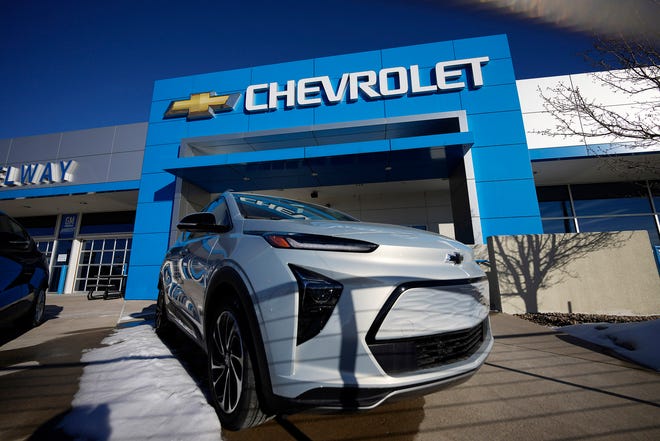General Motors will bring in more money than it expected this year despite an uncertain U.S. economy.
On Thursday, GM laid out its financial forecasts for investors, including an upward revision to year-end earnings. The automaker also said it is expanding the rollout of an improved online shopping tool for customers that will make buying a car easier and save the automaker and dealers thousands of dollars per vehicle. That savings will allow GM to offer more electric vehicles to customers at more affordable prices, CFO Paul Jacobson said during GM’s annual Investor Day in New York City.
“Our commitment is to lead the industry” in EV sales, Jacobson told reporters earlier in the day. “With the infrastructure we put in place and vehicles we reveal today, we have the plan to get there.”
Jacobson said GM is on track for its EVs to be “solidly profitable in 2025 in North America” as GM reaches a production capacity of 1 million EVs a year here. He declined to provide the profitability of GM’s current EV offerings.

Finally, while GM remains cautious in the near term for any U.S. economic hiccups, Jacobson said it continues to hire software engineers and eventually will resume a more aggressive hiring pace.
“There will be some growth, but we’re tempering that right now to manage against any headwinds. We still have no plans for any layoffs or furloughs,” Jacobson said. “We’ve slowed down hiring to be on the safe side of (any economic downturn). But as the business scales, we’ll need to increase our head count.”
GM’s economic forecast
GM has been in the process of transforming itself into a technology innovation company as it invests $35 billion in electric and autonomous vehicles by mid-decade. It remains on track to launch 30 new EVs by 2025, Jacobson said.
GM presently sells the Chevrolet Bolt and Bolt EUV on existing architecture. Demand for it is so strong, GM President Mark Reuss said, GM will increase production of the Bolt and Bolt EUV from 40,000 a year to more than 70,000 a year starting next year. The vehicles are built at Orion Assembly in Orion Township.
On its new Ultium propulsion system, GM is selling the GMC Hummer EV pickup and Cadillac Lyriq SUV. In the next few years, GM will launch the following EVs, also on Ultium: The 2024 Chevrolet Silverado EV, 2024 GMC Sierra EV, Hummer SUV, 2024 Cadillac Celestiq hand-built electric sedan, a 2024 Chevrolet Equinox EV at a starting price of about $30,000, a 2024 Chevy Blazer EV and the Buick Wildcat concept for an electric SUV.

Those upcoming EVs are key to GM’s future, CEO Mary Barra told investors. She said buyers of the Cadillac Lyriq have been mostly Gen X and Gen Y, a younger demographic than has been Cadillac’s typical buyer. She said the Lyriq and the Hummer are attracting customers who are new to GM. That, combined with GM’s strong loyalty rate, positions the company for high EV sales in the future.

“This is our moment and you are about to see how we will seize it,” Barra said.
Jacobson said GM expects EV adoption to approach 20% of U.S. industry sales in the next three years. By that time, GM will have multiple entries in pickup, SUV and luxury segments that represent about 70% of EV industry volume, he said. GM’s ability to bring those EVs to market is funded now by the highly profitable gasoline-powered large pickups and SUVs sold in North America.
To that end, Jacobson said strong demand for GM’s trucks is prompting the automaker to adjust its full-year earnings guidance. For the full-year 2022 adjusted automotive free cash flow is expected to increase to $10 billion to $11 billion from GM’s previous guidance of coming in at $7 billion to $9 billion. Free cash flow is like your checkbook; it’s the cash left after paying for expenses and toward an investment.
GM now projects 2022 adjusted earnings before interest and taxes (EBIT) for the full year will be in a range of $13.5 billion to $14.5 billion. GM’s previous guidance for adjusted EBIT was $13 billion to $15 billion. EBIT is an indicator of the company’s profitability and is calculated as revenue minus expenses excluding tax and interest.
Jacobson said the metrics take into account the volatile economic environment going into next year where GM expects new-vehicle demand to decline slightly from previous years, but still be healthy.
“We do think it’ll be a different environment and we’ve built that into our expectations,” Jacobson said.
GM’s key targets from 2023-25
In October of last year, at its annual Investor Day, Jacobson said the company’s EV revenue was expected to grow from $10 billion in 2023 to $90 billion annually by 2030 as GM launches new EVs in high-volume segments. He said connected vehicles and other new businesses will drive $80 billion in new, incremental revenue with most of the growth accelerating later in the decade.
During the investor meeting, GM leaders outlined several key performance indicators to illustrate its plan to increase profits in the upcoming years:
- GM revenue will grow at a 12% compound annual rate through 2025, reaching more than $225 billion as EV volumes and software revenue grow. Revenue from EVs will be more than $50 billion in 2025.
- GM to build 400,000 EVs in North America from 2022 through the first half of 2024, then increase capacity to 1 million units annually in 2025.
- GM is focused on reducing the cell costs for the next generation of its Ultium batteries in part because of strategic alliances with suppliers of the raw materials needed to make batteries.
- GM expects to announce the location “soon” for a fourth battery plant in its joint venture with LG Energy Solution called Ultium Cells LLC. Ultium Cells operates a plant near Lordstown, Ohio. It is building plants in Spring Hill, Tennessee, and Lansing.
- Total capital spending is expected to be $11 billion to $13 billion per year through 2025, paid for by continued sales of gasoline-powered pickups and SUVs.
- GM expects to earn low- to mid-single-digit EBIT-adjusted margins on its EV portfolio in 2025, before the positive impact of clean energy tax credits.
“This is really just the start for us,” Jacobson told the media referring to the expected profit growth of EVs. “When you think about the EV tax credit on top of it — we’re talking $3,500 to $5,500 per vehicle — we believe we’ll have internal combustion engine-like margins by 2025.”
GM’s other revenue opportunities
GM has other revenue possibilities from outside sources. Its majority-owned subsidiary, Cruise, is running a robotaxi service with self-driving Bolts in San Francisco. Cruise will soon expand to Austin, Texas, and Phoenix, Arizona, and GM will start building the Origin self-driving cars for Cruise at Factory Zero in Detroit and Hamtramck. Last year, then-Cruise CEO Dan Ammann said the ride-hailing business should reach $50 billion in revenue as it ramps up operations over the next six years.
Jacobson told reporters GM is still confident it can fund the $2 billion a year it committed to invest in its Cruise subsidiary. Cruise just started charging customers for rides in San Francisco.

“If we have to adjust, we will,” Jacobson said. “Cruise is an integral part of this and will expand to other cities. They’re making really good progress. As they get into revenue generation, we feel very good about how the business is tracking against that $50 billion (annual revenue) target in 2030.”
Also, GM’s BrightDrop — a technology startup that makes electric delivery vans and other delivery products — is on track to reach $1 billion in revenue in 2023, as GM’s CAMI plant in Ontario launches full production of the BrightDrop Zevo 600 delivery van next year, and projects building 50,000 units annually by 2025.
GM’s new digital retail platform
GM said it is expanding a new digital retail platform Thursday with U.S. dealerships to enhance the shopping and purchase experience for EV customers and reduce costs to GM by an estimated $2,000 per vehicle.
The new digital retail platform changes how GM handles its distribution and inventory management with its dealerships. GM has been rolling it out on the Bolt EV and, for customers, it means they can now do full online shopping and purchase, or opt for in-person sales at dealerships, or a combination of both.

“The digital retail platform is part of what we’re doing to reinvent the customer experience,” Jacobson said. “It’s a regional distribution strategy that will lower costs for us and our dealers. Customers can choose how they want to interact and purchase their vehicle.”
The $2,000 savings in lower distribution costs, Jacobson said, is factored into GM’s overall cost equation, making him “confident” GM will be able to “provide competitive pricing for our vehicles.”
More:2023 Prius hybrid debuts as Toyota struggles to regain green mantle
More:GM reports revenue and income surge, but challenges remain
Contact Jamie L. LaReau: jlareau@freepress.com. Follow her on Twitter @jlareauan. Read more on General Motors and sign up for our autos newsletter. Become a subscriber.